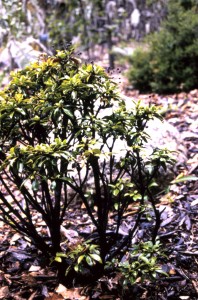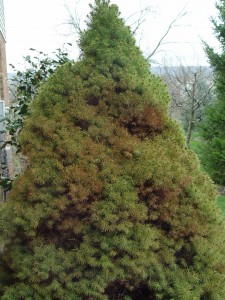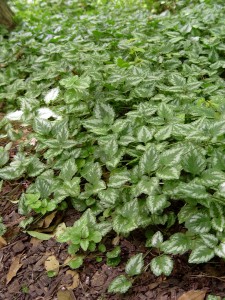George’s Not-Favorites
June 7th, 2011
I spend a lot of time telling people about all of the great plants worth trying – especially the new ones.
What also might help in your own home-landscape plant-selecting is a list of plants I’m not too wild about.
These are ones I’ve personally killed or know have significant drawbacks. They’re ones that other people tend to complain about when I’m out doing my Garden House-Calls home consults. Or they’re ones I just don’t like.
Your crap list is no doubt different than mine, but for what it’s worth, here are 10 of my non-favorites (along with somewhat-similar and better alternatives):
Forsythia. A two-week wonder that looks like a big shrubby weed the rest of the year. It’s been on my enemy list since I hurt my back trying to dig one out. (Alternatives: fothergilla, witch hazel, winterhazel.)
Mountain laurel. You’d think our state flower would do a better job of surviving. Hardly anyone around here has a healthy one in the landscape (doesn’t transplant well, hates clay, suffers root rot, resents heavy mulch). I’ve killed every one I’ve tried to grow. (Alternative: cherry laurel.)
Morning glory. A beautiful annual vine, especially the blue ones. But then it drops seed and comes back everywhere forever, including the nearby lawn. (Alternative: purple hyacinth bean.)
Yew. Way over-used. I’ve seen so many boxed-off or balled that I can’t erase the images of butchery. People with deer problems complain this is a top target. (Alternative: naturally pruned Japanese plum yew, Russian cypress.)
Azalea. Another two-week wonder that also has a high death rate if not given good drainage. Some people manage to get these to live a long-time with little care, but I also see a ton of really bad ones that have been butchered, discolored by lacebug attack or barely hanging on to dear life in clay. (Alternative: boxwood as an evergreen, hydrangea as a shady flowering substitute.)
Dwarf Alberta spruce. Handsome, slow-growing and neat at first, these almost always get attacked eventually by spider mites, which cause brown patchiness and often death. (Alternative: dwarf Hinoki cypress.)
Barberry. Hard to kill (which is why you see so many in McDonald’s parking lots and in builder-installed landscapes), but many of them seed into the wild and choke out native vegetation. Their thorns are deadly at pruning time. (Alternative: ‘Knock Out’ roses if you don’t mind thorns, St. Johnswort if you do.)
Rose-of-sharon. Also hard to kill, this summer-blooming shrub is showy but grows too big and too fast for most yards. Then it seeds to the point of being weedy in some yards. (Alternatives: viburnum, ninebark, tree-type hydrangeas.)
Yellow archangel (Lamiastrum). Not to be confused with lamium, this variegated groundcover doesn’t play well with any neighbor. It’s useful all by itself to colonize a shady, rocky bank, but woe to the gardener who plants it in a perennial garden. (Alternative: lamium, foamflowers, foamybells.)
Burning bush. People love the red fall color, but the leaves often blow off 2 days after they finally turn. Otherwise, these create lots of pruning work, are bare or plain green 360 days of the year, and seed into the wild (and nearby). (Alternative: blueberries, Virginia sweetspire.)
Bonus enemy: Ribbon grass. This variegated grass looks great in a pot or in that little clump the neighbor offers. But once in the ground, runners run everywhere and soon pop up where you don’t want it. Like yellow archangel, isolate it if you use it… and not in full sun. (Alternative: switchgrass, prairie dropseed, Pennsylvania sedgegrass.)










